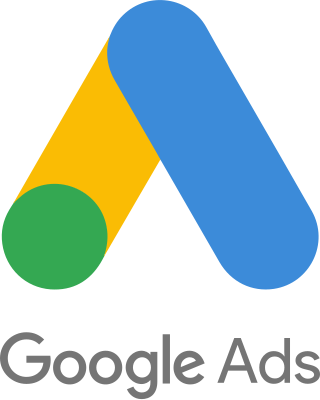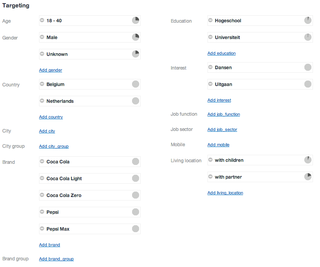Related Research Articles
Digital display advertising is online graphic advertising through banners, text, images, video, and audio. The main purpose of digital display advertising is to post company ads on third-party websites. A display ad is usually interactive, which allows brands and advertisers to engage deeper with the users. A display ad can also be a companion ad for a non-clickable video ad.
Google AdSense is a program run by Google through which website publishers in the Google Network of content sites serve text, images, video, or interactive media advertisements that are targeted to the site content and audience. These advertisements are administered, sorted, and maintained by Google. They can generate revenue on either a per-click or per-impression basis. Google beta-tested a cost-per-action service, but discontinued it in October 2008 in favor of a DoubleClick offering. In Q1 2014, Google earned US$3.4 billion, or 22% of total revenue, through Google AdSense. In 2021, more than 38 million websites used AdSense. It is a participant in the AdChoices program, so AdSense ads typically include the triangle-shaped AdChoices icon. This program also operates on HTTP cookies.

Google Ads, formerly known as Google Adwords, is an online advertising platform developed by Google, where advertisers bid to display brief advertisements, service offerings, product listings, and videos to web users. It can place ads in the results of search engines like Google Search, mobile apps, videos, and on non-search websites. Services are offered under a pay-per-click (PPC) pricing model, and a cost-per-view (CPV) pricing model.
Pay-per-click (PPC) is an internet advertising model used to drive traffic to websites, in which an advertiser pays a publisher when the ad is clicked.

Banner blindness is a phenomenon in web usability where visitors to a website consciously or unconsciously ignore banner-like information. A broader term covering all forms of advertising is ad blindness, and the mass of banners that people ignore is called banner noise.
An online advertising network or ad network is a company that connects advertisers to websites that want to host advertisements. The key function of an ad network is an aggregation of ad supply from publishers and matching it with the advertiser's demand. The phrase "ad network" by itself is media-neutral in the sense that there can be a "Television Ad Network" or a "Print Ad Network", but is increasingly used to mean "online ad network" as the effect of aggregation of publisher ad space and sale to advertisers is most commonly seen in the online space. The fundamental difference between traditional media ad networks and online ad networks is that online ad networks use a central ad server to deliver advertisements to consumers, which enables targeting, tracking and reporting of impressions in ways not possible with analog media alternatives.
Online advertising, also known as online marketing, Internet advertising, digital advertising or web advertising, is a form of marketing and advertising that uses the Internet to promote products and services to audiences and platform users. Online advertising includes email marketing, search engine marketing (SEM), social media marketing, many types of display advertising, and mobile advertising. Advertisements are increasingly being delivered via automated software systems operating across multiple websites, media services and platforms, known as programmatic advertising.
Search engine marketing (SEM) is a form of Internet marketing that involves the promotion of websites by increasing their visibility in search engine results pages (SERPs) primarily through paid advertising. SEM may incorporate search engine optimization (SEO), which adjusts or rewrites website content and site architecture to achieve a higher ranking in search engine results pages to enhance pay per click (PPC) listings and increase the Call to action (CTA) on the website.
In web search engines, organic search results are the query results which are calculated strictly algorithmically, and not affected by advertiser payments. They are distinguished from various kinds of sponsored results, whether they are explicit pay per click advertisements, shopping results, or other results where the search engine is paid either for showing the result, or for clicks on the result.

Microsoft Advertising is an online advertising platform developed by Microsoft, where advertisers bid to display brief ads, service offers, product listings and videos to web users. Provides pay per click advertising on search engines Bing, Yahoo! and DuckDuckGo, as well as on other websites, mobile apps, and videos.

A domain name auction facilitates the buying and selling of currently registered domain names, enabling individuals to purchase a previously registered domain that suits their needs from an owner wishing to sell. A Drop registrar offers sales of expiring domains; but with a domain auction there is no need to wait until a current owner allows the registration to lapse before purchasing the domain you most want to own. Domain auction sites allow users to search multiple domain names that are listed for sale by owner, and to place bids on the names they want to purchase. As in any auction, the highest bidder wins. The more desirable a domain name, the higher the winning bid, and auction sites often provide links to escrow agents to facilitate the safe transfer of funds and domain properties between the auctioning parties.
Keyword advertising is a form of online advertising in which an advertiser pays to have an advertisement appear in the results listing when a person uses a particular phrase to search the Web, typically by employing a search engine. The particular phrase is composed of one or more key terms that are linked to one or more advertisements. The most common form or keyword advertising, focused on payment methods, is pay per click (PPC), with other forms being cost per action (CPA) or cost per mille (CPM).
In Internet marketing, search advertising is a method of placing online advertisements on web pages that show results from search engine queries. Through the same search-engine advertising services, ads can also be placed on Web pages with other published content.
Keyword research is a practice search engine optimization (SEO) professionals use to find and analyze search terms that users enter into search engines when looking for products, services, or general information. Keywords are related to search queries.

Targeted advertising or data-driven marketing is a form of advertising, including online advertising, that is directed towards an audience with certain traits, based on the product or person the advertiser is promoting.
Quality Score is a metric used by Google, Yahoo!, Facebook and Bing that influences the ad rank and cost per click (CPC) of ads.
Microsoft adCenter Labs, is an applied research group at Microsoft that supports Microsoft adCenter. Microsoft adCenter, is the division of the Microsoft Network (MSN) responsible for MSN's advertising services.
A demand-side platform (DSP) is a concept that combines various software for advertisers to automate the process of buying and selling ad impressions in real time.
Ad text optimization (ATO) is the process of improving the performance of a text Pay Per Click (PPC) Advertisement on search engines by improving its Click Through Rate (CTR) performance both in terms of volume and quality of response, that is “more buyers, less browsers”. ATO is an element of Search engine optimization, where the subject is discussed in greater detail.
Local search engine optimization is similar to (national) SEO in that it is also a process affecting the visibility of a website or a web page in a web search engine's unpaid results often referred to as "natural", "organic", or "earned" results. In general, the higher ranked on the search results page and more frequently a site appears in the search results list, the more visitors it will receive from the search engine's users; these visitors can then be converted into customers. Local SEO, however, differs in that it is focused on optimizing a business's online presence so that its web pages will be displayed by search engines when users enter local searches for its products or services. Ranking for local search involves a similar process to general SEO but includes some specific elements to rank a business for local search.
References
- ↑ "400+ Negative Keywords You Need To Use In AdWords". Paid Insights. 2016-01-31.
- ↑ "Using keyword matching options - AdWords Help". support.google.com. Retrieved 2015-10-09.